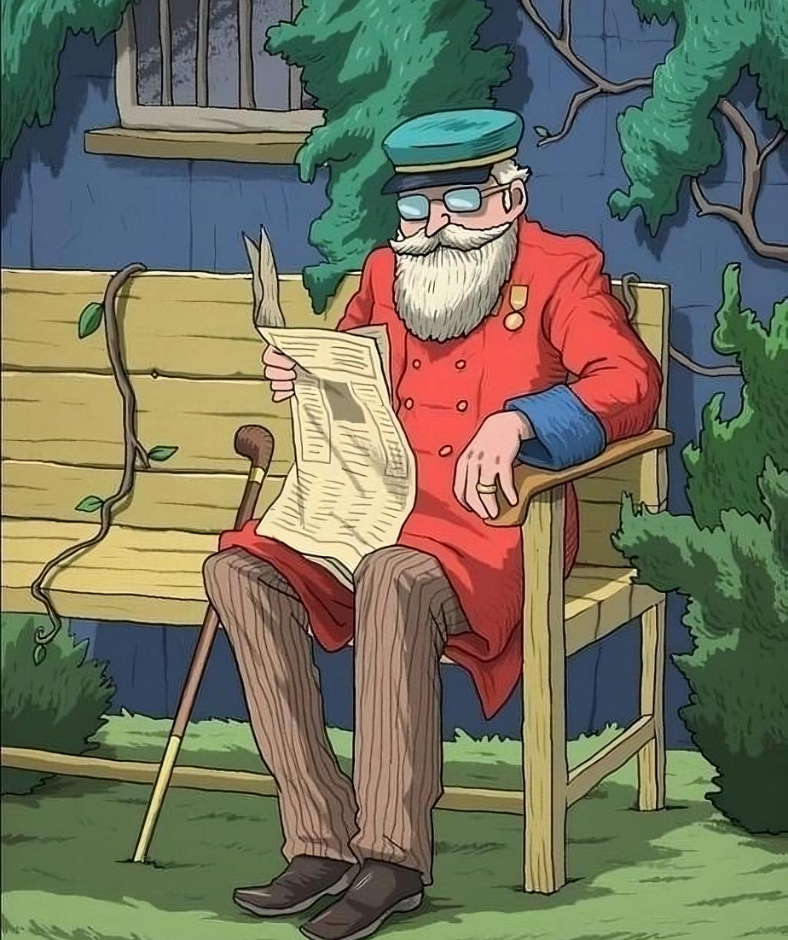Only 2% can find the lost pipe! You try now!
Are you ready for a brain-teasing challenge that will put your observation skills to the ultimate test? Here’s a visual puzzle that’s stumped even the sharpest eyes: an elderly gentleman has misplaced his beloved pipe, and he needs your help to find it. Are you one of the 2% who can spot it?
Let’s dive into the details, set the scene, and guide you to uncover the cleverly hidden treasure. Are you game?
The Puzzle: Where Is the Missing Pipe?

Picture this: an elderly gentleman is seated on a rustic bench outside his quaint home. Dressed in a red, embellished top and striped brown trousers, he’s fully engrossed in reading his newspaper. Beside him rests his trusted walking cane, and vines snake their way around the bench, adding a touch of charm to the scene.
The task is simple—find his missing pipe. But is it really that simple? Not quite! The pipe is cleverly camouflaged, blending seamlessly into the scene. It might be hiding in the background, among the plants, or perhaps even disguised as part of another object.
Before you read on, take a moment to examine the scene in your mind’s eye. Can you spot the pipe?
Why This Puzzle Is So Tricky
Clever Disguises Play Tricks on Your Mind
The beauty of this puzzle lies in its subtle misdirection. Your brain naturally looks for an object that resembles a pipe in the most obvious places—on the bench, among the vines, or perhaps on the ground. But this riddle throws a curveball by disguising the pipe as something else entirely.
It Tests Your Attention to Detail
In a world full of distractions, puzzles like these force you to focus on the finer details. It’s not about scanning the image quickly but about observing every element closely, almost as if you’re piecing together a mystery.
The Power of Assumptions
Most people fail to find the pipe because they assume it will look exactly like a traditional smoking pipe. This puzzle challenges that assumption, pushing you to think outside the box.
Hint: Look at His Belongings
Still stuck? Here’s a clue to nudge you in the right direction: the missing pipe isn’t hiding among the plants or on the ground. Instead, it’s cleverly disguised as part of an object that the elderly gentleman already has with him.
Take a closer look at his walking cane. Could it be more than just a cane?
The Solution: The Pipe Was Hiding in Plain Sight

If you’ve given it your best shot and are ready for the answer, here it is: the missing pipe is ingeniously integrated into the design of the man’s walking cane. What appears to be the cane’s handle is, in fact, the man’s cherished smoking pipe.
This creative disguise is what makes the puzzle so challenging. Your eyes naturally scan the scene for something separate and distinct, not for a dual-purpose object.
Why Observation Skills Matter
Puzzles like this one aren’t just fun—they’re also a fantastic way to sharpen your observation and critical thinking skills. Here’s how they benefit you:
Improves Focus and Attention to Detail
In today’s fast-paced world, it’s easy to overlook the small things. Solving visual puzzles helps you slow down, focus, and train your brain to notice subtle differences.
Encourages Creative Thinking
The pipe-in-cane design demonstrates how thinking outside the box can lead to unexpected solutions. It’s a reminder to question assumptions and explore alternative possibilities.
Boosts Cognitive Function
Engaging in activities like puzzles stimulates your brain, improving memory, problem-solving skills, and overall mental agility. It’s like a workout for your mind.
The Art of Visual Puzzles
Visual puzzles like this one have captivated people for generations. They tap into our natural curiosity and challenge us to see beyond the obvious. But why do we find them so intriguing?
A Sense of Achievement
There’s something deeply satisfying about solving a tricky puzzle. It gives you a small but meaningful sense of accomplishment, like cracking a secret code.
They Appeal to All Ages
From kids to seniors, everyone loves a good puzzle. It’s a timeless activity that bridges generations and sparks friendly competition.
They’re Fun and Educational
Puzzles aren’t just entertaining—they’re also a great way to learn. They teach patience, perseverance, and the value of looking at things from different perspectives.
Tips for Solving Puzzles Like a Pro
If you want to improve your puzzle-solving skills, here are a few tips to keep in mind:
- Take Your Time: Don’t rush. The best discoveries often come when you slow down and really look.
- Change Your Perspective: If you’re stuck, try looking at the scene from a different angle. Sometimes a fresh perspective is all you need.
- Focus on Unlikely Spots: Pay attention to areas you’d usually overlook. Puzzles often hide solutions in the least obvious places.
- Practice Regularly: Like any skill, solving puzzles gets easier with practice. The more you do, the sharper your observation skills will become.
Challenge Your Friends
Think you’re in the top 2% who can spot the pipe? Share this puzzle with your friends and family to see if they can match your skills. It’s a fun way to test their observation and creative thinking abilities. Plus, it’s always interesting to see how different people approach the same challenge.
Conclusion: The Pipe Was Right There All Along
This deceptively simple puzzle proves that the best solutions are often hidden in plain sight. The elderly gentleman’s pipe wasn’t lost at all—it was cleverly disguised as part of his walking cane. It’s a perfect example of how our assumptions can mislead us and why it’s important to look closer, think differently, and stay curious.
So, did you find the pipe before reading the solution? If not, don’t worry—you’re in good company. Challenges like these remind us to embrace the thrill of discovery and the joy of seeing the world in new ways. Now, go share this puzzle with others and watch as they try to uncover the cleverly hidden secret!






